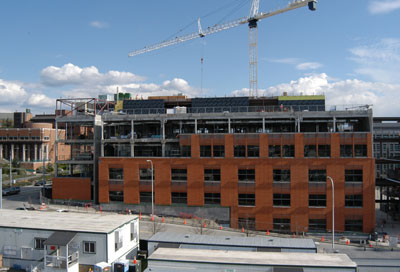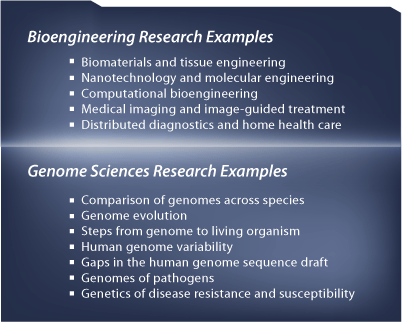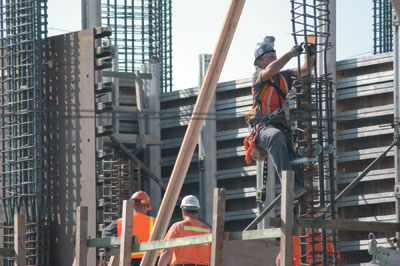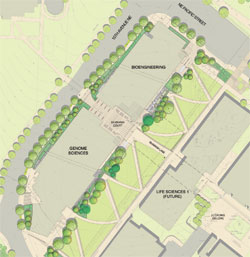An Inside Look
Genome Sciences and Bioengineering Buildings Take Shape
The genome sciences and bioengineering buildings, rising adjacent to each other on the south side of the University of Washington campus, will accommodate the work styles of their occupants. Genome scientists, for example, will have offices embedded inside their labs. Bioengineers will have office suites next to their labs.
Designing for Science
The architects paid attention to how scientists and engineers do their research and interact with each other. Their goal was to design an intellectually charged, collegial setting for discovery to take place.

A view of the building from the west campus parking garage.
The two buildings will form a quadrangle with the Oceanography and Life Sciences buildings. The land has a lakeshore slope, forming a level on three grades, and the quadrangle opens to a view of Portage Bay. The buildings, connected by a footbridge, will have main entrances on Skamania Lane facing the center of the quad.
Inside will be large conference rooms and informal meeting spaces with tables, chairs, and whiteboard walls for spontaneous brainstorming and sketching ideas. Some glass windows will have prism sunshades that divide light into sparkling rainbows. The south end will have an auditorium and a rooftop cafe with outdoor seating and lake vistas. The Burke Gilman Trail and the astronomy sundial can be seen from the north end.
"Brick-colored terra cotta tile panels will relate the exterior to other UW campus buildings yet be more modern," said Paul Zajfen, design partner at Anshen + Allen Los Angeles, the architectural firm for the buildings. Because Seattle has heavy rains and seismic events, building materials have been tested for durability during earthquakes and impermeability to water leakages.
Constructing Laboratories
Bart Eberwein, vice president for Hoffman Construction, said his company enjoys working on anything with biotech in the title: research facilities on university campuses and in the private sector. Hoffman is constructing the genome sciences and bioengineering building, and this past year completed the UW Medical Center Surgery Pavilion.
"Some of the world's problems might be solved with science: food production, pollution, relief of illness." he said. "When our company constructs these buildings, we feel part of something that will help with mankind's larger challenges."

Eberwein also pointed out that the United States has declined in manufacturing and grown in discovering and inventing. His 80-year-old company used to erect more factories, and is now building more think tanks and laboratories.
These, he believes, are more difficult but more rewarding than putting up a strip mall, because the indoor environment has to be exactly right.
"Every worker knows that the mechanical systems, the heating, air-conditioning, piping, wiring, and dehumidifiers can't go wrong, because lab conditions have to be consistent everyday," Eberwein said. "If there are wild swings, data can be lost." He mentioned the sophisticated instrumentation and controls being installed. These are tested under a variety of simulations, such as a three-day freeze, to be sure nothing fluctuates.
Eberwein, who noted the beauty of Anshen +Allen's design, hopes that the new buildings help UW scientists and students meet their mission and take pride in their surroundings, and that they favorably impact their creative energy and well-being.
A Home for Bioengineering
"My department has been looking forward to this day for 40 years," said Dr. Yongmin Kim, professor and chair of bioengineering, at the groundbreaking for the two buildings. After the move, the department's faculty offices will be located together for the first time in its history, instead of scattered in nine areas across campus.

At the construction site, an iron worker prepares rebar for concrete forms.
The building will foster impromptu hallway discussions between faculty and students. Kim added that the ability to interact in common areas would not only improve the exchange of ideas, but also bring more cohesiveness among bioengineering students.
Despite the disadvantages of dispersed office, lab, and teaching spaces, the graduate program in the UW Department of Bioengineering is among the top of its type in the United States.
"The new facilities will allow the department to achieve the next level of educational excellence," Kim said.
In research, the department emphasizes five areas: biomaterials and tissue engineering; nanotechnology and molecular bioengineering; computational bioengineering; medical imaging and image-guided treatment; and distributed diagnostics and home health care.
 |
| The building is designed to foster the exchange of ideas among researchers and cohesiveness among students. |
Progress is accelerating on several fronts. The UW is pioneering tissue engineering for such vital organs as the heart and esophagus. Researchers are attempting to assemble nano-sized particles for delivering medications to targeted points in the body. Other UW research has led advances in molecular imaging and in diagnostics that can detect the start of some illnesses before symptoms appear. In home health care, researchers are finding ways to monitor chronic conditions in the comfort of a patient's home by using sensors and computers to analyze patient data.
"UW bioengineers are transforming health care. The UW has one of the nation's few departments jointly run by a medical school and a college of engineering," Kim said.
Bioengineering is looking forward to being neighbors of the Department of Genomic Sciences. The two departments will expand collaborations in such areas as biosynthesis, protein interactions, and molecular structure.
New Quarters for Genome Sciences
In its quarters, the Department of Genome Sciences will take on equally demanding work. Some recently recruited faculty members will address residual issues in sequencing the human genome, particularly gaps in the sequence.
Other researchers will compare genomes of various species to chart evolutionary changes, catalog the genetic information that species share, and estimate when certain lineages diverged.
For example, when animals as disparate as chickens and dogs share similar pieces of the genome, a basic function is likely being preserved across mammals and birds, according to Dr. Robert Waterston, professor and chair of genomic sciences. "In the Darwinian view, deleterious changes are filtered out. We want to see what the copy editor we call natural selection cared about and thought was important to keep in the genome of a variety of animals."
When species are more closely related, genomic scientists are interested, not so much in similarities, but in genetic differences. Such comparative studies in evolutionary biology have medical implications: Why do aging humans have more risk of solid tumors than do other primates? People evolved to stand on two feet, at the cost of sore backs and bad knees. What other evolutionary compromises were made?
Among other quests to be undertaken in the new facilities is how genome-bounded instructions end up as functioning, living creatures. The data passed from parent to offspring through DNA is no more than that: information.
"There's an immense knowledge gap between the molecular biology of genetics and the complexity of the organism formed from the genetic code," Waterston said. " Will we be able to figure out how molecules organize products and metabolites to create a life form as complicated as people?" Waterston believes that UW scientists will make significant contributions in this area.
Another central preoccupation in biology, human and otherwise, is genetic variations among individuals of the same species. Several studies on genetic variation, its implications in disease resistance and susceptibility, and how deterministic is genetics in setting the course of diseases, will continue in the new building.
Commenting on the potential effects of the new genomic sciences facility, Waterston observed, "History tells us if we ask the right scientific questions, and we build investigative resources equal to the task, dramatic things will happen."
The building costs are funded with a $70 million gift from the Bill & Melinda Gates Foundation, a $10 million gift from the Whitaker Foundation, $12 million in federal government grants, and private gifts from other sources.
